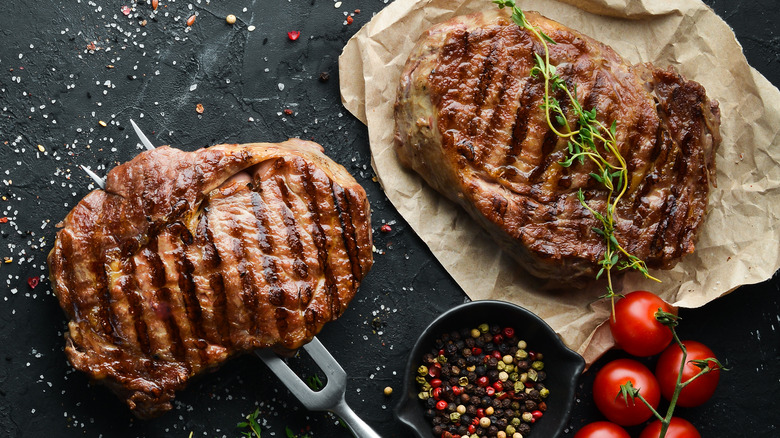Filet Mignon Vs. Ribeye: What's The Biggest Difference?
You're staring down a meat counter or steakhouse menu in the mood for a juicy steak. But, it's so hard to choose! Let us help make your next steak purchase less fraught with indecision.
A primary consideration for choosing any steak is understanding they're cut from different muscles from various parts of the animal's body. Some muscles don't work as hard as others. The amount a muscle works is crucial in determining how tender the meat will be. For example, filet mignon is a steak cut from the center of the tenderloin. This muscle runs along the interior of the cow's spine and doesn't get any heavy labor. Because of this, they're often referred to as fork-tender (via Chef's Last Diet).
Another essential component of enjoying your steak is its fat content. Interestingly, not all flavors are created in the same way. Scent is a major contributor to the enjoyment of fat. Tasting is a collection of sense responses. Nerves in our eyes and nose, as well as our taste buds, contribute to the sensation of flavor. You may have had the experience of tasting a burger on the grill before you have a bite. You were responding to the smell of cooking fat stimulating your taste system, called the common chemical sense (via Verywell Health).
And so, with this said, how are the filet mignon and ribeye different?
The noted differences between filet mignon and ribeye
As Smoked BBQ Source notes, filet mignon is universally considered the most tender steak; though some say it pays for its soft texture in flavor. Filet mignon is also among the leanest steaks available (per Livestrong), with very little fat. Due to this deficit, filets can quickly dry out if they're overcooked. To avoid this, filet mignon is best served rare to medium-rare, according to Martha Stewart. They're a smaller-sized cut, and they're often larded with bacon (as pictured above) to keep them juicy and impart more flavor.
Unlike the filet mignon, ribeye is much larger in size and contains a higher fat content. Ribeye steaks are cut from a roast nestled under the rib cage; this lesser-used muscle is generously marbled with intramuscular fat, which significantly impacts the tastiness of a steak. The tomahawk cut is a favorite bone-in cut, sometimes weighing up to 40 ounces. Boneless ribeye is also popular and can be a thinner, smaller portion. There's a debate about whether the bone imparts flavor or not (via Steak School by Stanbroke). With its full rib thickness and extended frenched bone, though, there's no doubt that the tomahawk cut is a dramatic presentation.
But don't worry if you aren't feeling like a Flinstone, both the filet mignon and ribeye are famously tender, with a few noted differences; most notably in regards to size, fat content and consequent flavor, and presentation. (These two steaks are also highly ranked in our ranking of the most popular cuts of steak: number three and number one, respectively).

